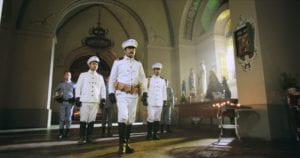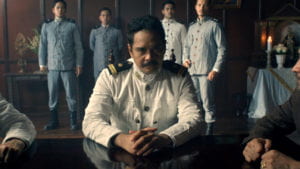2015 | 1h 58 | Written by Henry Francia, Ed Rocha, and Jerrold Tarog | Directed by Jerrold Tarog

“Heneral Luna is a powerful examination not only of one man’s life but, more significantly, of the theme that Filipinos are their own worst enemies—a theme that resonates mightily in these times.”
— Luis Francia, writer/historian/columnist (Philippine Inquirer)/professor (NYU)
”An engaging narrative, supported by wonderful cinematography and grounded on sound historical research.”
—Ambeth Ocampo, historian/columnist (Philippine Inquirer)
After his activities in the Reform Movement at the end of the Spanish colonial rule, Madrid-educated Antonio Luna emerges as one of the fiercest generals of the Philippine army in the Philippine-American war that followed the Declaration of Philippine Independence. The short-tempered general finds himself facing an enemy more formidable than the American army: his own treacherous countrymen.
Cast: John Arcilla (General Antonio Luna), Mon Confiado (Emilio Aguinaldo), Aaron Villaflor (Joven Hernando), Bing Pimentel (Doña Laureana Luna), Mylene Dizon (Isabel), Joem Bascon (Col. Paco Roman), Alvin Anson (Gen. Jose Alejandrino), Lorenz Martinez (Gen. Tomas Mascardo), Alex Medina (Capt. Jose Bernal), Art Acuña (Maj. Manuel Bernal), Archie Alemania (Capt. Eduardo Rusca), Epy Quizon (Apolinario Mabini), Leon Martinez (Pedro Paterno), Nonie Buencamino (Felipe Buencamino), Ed Rocha (Capt. Elwell Stephen Otis), Greg Dorris (Gen. Wesley Merritt), Miguel Faustmann (Gen. Arthur MacArthur)
Production: TBA Studios
Awards:
| Film Academy of the Philippines | Best Picture, Director, Screenplay, Actor, Supporting Actor, Cinematography, Production Design, Editing, Sound, Musical Score |
| Gawad Urian | Best Direction, Editing, Cinematography |
About the Director
Jerrold Tarog co-wrote, directed, and edited Heneral Luna and composed its musical score. He cites Stanley Kubrick’s Paths of Glory as a major inspiration for Heneral Luna. Tarog grew up as an only child, with a father living abroad as an OFW (Overseas Filipino Worker). He studied agribusiness at the University of the Philippines (UP) in Laguna but after failing all the agribusiness subjects, he transferred to UP in Metromanila where he studied music composition. He started his career as a composer for films, including those by Brillante Mendoza, a major force as director and producer in the current renaissance of Philippine indie films. Tarog made his directing debut with the inventive and hilarious mockumentary, CONFESSIONAL. It won the First Feature Competition Award at the Cinefan Festival of Asian and Arab Cinema. (With luck, you can still catch it on YouTube on the Cinema One Channel.) He then went on to direct contemporary dramas and horror films, winning awards from Cinema One, Cinemalaya, the Urian, and the Young Critics Circle for directing or musical scores.
About the Film
 The film is set between December 1898 and June 1899, during one of the most pivotal, fraught, tangled, and confusing periods in Philippine history. Heneral Lunaforges force and form from this hopelessly mixed-up period by focusing on its title character, General Antonio Luna (John Arcilla). Though not necessary for following the plot, a de-entangling historical and biographical backgrounder would vastly complement and enrich a viewing of this historical epic.
The film is set between December 1898 and June 1899, during one of the most pivotal, fraught, tangled, and confusing periods in Philippine history. Heneral Lunaforges force and form from this hopelessly mixed-up period by focusing on its title character, General Antonio Luna (John Arcilla). Though not necessary for following the plot, a de-entangling historical and biographical backgrounder would vastly complement and enrich a viewing of this historical epic.
In 1896, the Philippine Revolution against Spain erupted, fed by the execution of the nationalist novelist Dr. Jose Rizal, a trail of land grabs and other abuses by Spanish friars, a history of suppressed revolts, and liberal currents animating well-to-do Filipinos coming back from studies in Barcelona and Madrid.
Among the leaders of the Revolution was General Emilio Aguinaldo (in many ways the film’s main antagonist) who would eventually be elected President of the revolutionary Philippine Republic. Pre-figuring the later assassination of Antonio Luna, he ordered the execution of another revolutionary leader, Andres Bonifacio, whom he deemed a threat to his leadership. Nevertheless, the insurgents managed to continue putting the Spanish forces on the defensive and establishing garrisons across the main island of Luzon. After suffering military setbacks, however, Aguinaldo entered in December 1897 into a peace pact with the Spanish authorities. He received amnesty and monetary reward in exchange for dissolving the provisional government and immediate banishment to Hong Kong where he nevertheless organized a revolutionary government-in-exile.
In the meantime, the Spanish-American war erupted in April 1898 with the mysterious explosion and sinking of the USS Maine in the Cuban harbor. About a week later, the first battle of the war broke out in Manila Bay where the US squadron decimated the Spanish forces that had already been weakened by the Philippine Revolution. A couple of weeks later, Admiral Dewey provided transport for Aguinaldo to come back to the Philippines and continue the Philippine Revolution, thereby helping the US finish off the Spaniards. Aguinaldo quickly resumed command of the Revolutionary army which would soon surround Intramuros, the walled center of the Spanish Crown in Manila.
Now enters our film’s protagonist Antonio Luna into his most famous role, as the fiercest general of the Revolutionary forces. Born of a wealthy merchant family with Spanish blood through his mestiza mother, he grew up an ilustrado, part of the class of native-born educated middle-class and elite Filipinos in the 19th century. Like many an ilustrado, he was a renaissance man, skilled in the arts and the sciences. He played the guitar and performed Liszt sonatas on the piano to the flutter of the ladies. He published well-received papers on chemistry and tropical diseases. His equally famous and hot-tempered brother Juan, the painter, won the gold medal in the 1884 Madrid Exposition of the Arts.
Antonio’s family sent him to study Pharmacy in Barcelona and Chemistry in Madrid, where he fraternized with a now famous group of ilustrado expatriates, including the novelist/physician/sculptor/poet Jose Rizal (who would eventually become the Philippine national hero). Like the others in their group that defiantly dubbed themselves Los Indios Bravos, after the derogatory name Spaniards used for native Filipinos, Luna embraced the Spanish liberal and European nationalist ideals of the time and wrote for La Solidaridad, the expatriate fortnightly that espoused major economic and political reforms in the Philippines. The Spanish government, impressed with his scientific abilities, commissioned him to study tropical and communicable diseases at the Pasteur Institute, and upon his return to Manila, he captured the competitive post of chief chemist at the Laboratorio Municipal de Manila.
As a Reformist, he did not take an active role in the first Philippine Revolution of 1896 but was nevertheless implicated and imprisoned by the Spanish authorities, first in Manila, then in Madrid’s Carcel Modelo, but was soon released to poke around Spain and Europe after the intercession of his celebrated painter brother.
The resumption of the fight against Spain and the sudden intrusion of America into Philippine history impelled Luna to purchase a berth on the next ship back to Manila, arriving in July 1898 and immediately volunteering for the Philippine Revolutionary forces. Having studied military science and guerilla warfare during his time in Madrid, he immediately rose to become Chief of the Philippine Army.
In the course of a few months, he forged together forces that had been disintegrating into regionalist and sometimes antagonistic groupings, mandated a national army uniform, established a military academy, and executed military plans that included trench and guerilla warfare. His glaring short fuse, insolent and brutal at times, in responding to the factionalism threatening to destroy the unity of the army, produced enemies within the leadership of the Republic. And he was becoming too powerful for the taste of President Aguinaldo and his supporters, which brings us to the main conflict and the beginning of the film.
After a framing scene of a young journalist interviewing Luna, the film’s first set piece finds Luna and Aguinaldo (Mon Confiado) at a raucous Presidential Cabinet meeting in December 1898 in Malolos, where the revolutionaries had declared Philippine Independence on June 12 earlier that year (now celebrated as the country’s National Day). The film’s main conflict is dramatized in the scene, with one group including Aguinaldo either believing American promises to support an independent Republic or on the other hand not caring about American intentions as long as their profitable businesses remain undisturbed. Another group, led by a fiery Luna, advocates a pre-emptive strike on the skeletal American forces stationed in Intramuros before American reinforcements arrive. Just a few months earlier in August, American and Philippine troops had fought side by side to finally put the Spaniards to rout in the Battle of Manila.
As it turns out, Luna’s instincts were right. Unbeknownst to their then Philippine allies, the United States was already working with Spain on the December 1898 Treaty of Paris that would end the Spanish-American war and, in exchange of payment, enable the United States to take over as possessor and ruler of former Spanish colonies including the Philippines. The Philippine-American war soon breaks out, in February 1899, with Antonio Luna the fiercest and most passionate general on either side.
As the film continues, it explores themes – at times too bluntly stated for this writer’s taste – of self versus country, wishful thinking versus instinct, calculation versus passion, and narrow self-interest versus wider ideals. Luna would generally embody the latter of these dualities, Aguinaldo and his faction the former. The lack of that unity that Luna espoused so passionately, at times in spectacularly harsh ways, would eventually doom a Revolution that had all the promise of going the way of the South Americans earlier in the century. The film proposes that it was not as much the superior arms of the Americans as it was the disintegrative regionalism and factionalism in the Philippine forces that would cause its defeat. (On somewhat of a flip side, unarmed unity proved itself more powerful than superior weaponry when it defeated the Marcos dictatorship in the People Power Revolution of 1986.)
The film’s reflection of a post-People-Power contemporary Philippines where, when vigilance sleeps, factionalism reasserts itself at the expense of national unity, resonated among a public that made it the most financially successful Philippine historical film of all time.
The end of Antonio Luna’s life, as shown in the film, is savage and bloody. Though Tarog blocks the assassination to echo Juan Luna’s most famous, gigantic painting, El Spoliarium, the unmitigated brutality is not exaggerated and is based on first-hand accounts.
The matter of narrow self-interest versus vaster ideals — and the gray areas in between, and the times when gray areas evaporate or collapse of necessity — would always remain relevant so long as man lives in society.
— Gil Quito
Stream the Movie
In coordination with its producer TBA Studios, Sulo has ensured that Heneral Luna will available on the TBA Studios’ YouTube Channel from April 16-22.